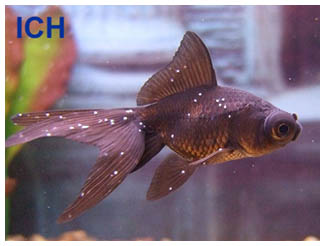Basic Marine Fish Diseases and Treatments Overview
Any aquarist who has ever had a sick fish knows just how stressful and discouraging it can be. If you havenít had a sick fish, itís just a matter of time until you do. You need to be able to recognize when a fish is sick and know how to treat the fish before itís too late.
Here are the three most common fish diseases and recommended treatments.
ICH

Ich is the most common disease in marine aquariums, and it probably encompasses at least 60-75% of cases of sick fish. Fortunately, itís the least deadly of the three most common fish diseases.
Ich is a parasite that is ever present in the environment. The first noticeable symptom of ich is a fish rubbing or scratching its body against the rocks or sand in an aquarium. It then progresses to white spots covering the fish. Ich will then leave the fish to live on the aquarium substrate, and it will often re-infect the fish. Ich can kill fish if it gets out of control and some fish are more prone to ich than others. Smooth-skinned fish such as tangs are particularly vulnerable.
There are several ways to treat ich. The easiest is using hypo-salinity. Hypo-salinity is the lowering of the salinity in the aquarium to a level where the fish can survive but the parasite cannotótypically a specific gravity of 1.016 to 1.017.
The strongest and recommended approach is to use a copper-based medication such as
Copper Power. These medications will quickly eliminate ich within 1 to 2 weeks. When using any copper medication it is important to also test for copper using a corresponding copper test kit such as the
Seachem Copper Test Kit.
Although copper and hypo-salinity are effective, both of these methods kill coral and invertebrates. If your tank has both fish and coral then you will need to remove the fish to a hospital tank before treating or trying one of the reef-safe medications such as
Kordon Herbal Ich Attack.
Another treatment option is to perform a freshwater dip on your fish. This is done by catching the sick fish and placing them in a bath of fresh water for around 10 minutes and then returning them to the tank. When doing this itís important to make sure that the dip water is close to the same temperature as the aquarium water, and itís also important that you are using dechlorinated tap water rather than RO water as the pH is likely closer to the pH in your aquarium. To dechlorinate water use
Seachem Prime.
Although
UV sterilization will not treat a fish infected with ich, it will prevent the transmission of ich from one fish to another.
MARINE VELVET
Marine velvet is more deadly than ich, and it can kill fish in under a week. It manifests itself as very fine powderlike spots on the body of the fish and can make a fish appear washed out or faded in coloration. Marine velvet is often confused with ich but the spots are much smaller and the disease spreads and kills far faster.
To treat marine velvet use copper medications such as
Copper Power or a formalin based medication such as
Kordon Rid Ich Plus. Keep in mind, these medications will kill coral and invertebrates. If there are invertebrates in the aquarium the fish must be removed for treatment. There are no reef-safe marine velvet medications available.
If you have invertebrates in your main tank, and no hospital tank, the only other option is to dip the fish in a formalin bath which is a mixture of a medication like
Kordon Rid Ich Plus and water. This dip can prove stressful for the fish, but without treatment, most fish with marine velvet will die within a week.
BROOKLYNELLA
Brooklynellaósometimes called clownfish disease or simply brookóis a disease that occurs almost exclusively with clownfish. Its symptoms are similar to marine velvet and itís just as lethal. But the disease itself can often be eliminated much faster.
Just like velvet, brook usually manifests itself as tiny white spots on a fish or a washed-out or faded appearance. If these symptoms are observed on a clownfish, the fish almost certainly has brooklynella and will likely die within a week.
To treat brooklynella use either a freshwater dip (
as described for ich) or an aldehyde-based medication such as
Seachem ParaGuard or
Kordon Rid Ich Plus. Some hobbyists will also mix the medications into the freshwater dip to increase their potency. Keep in mind, once again, these medications will kill invertebrates, so the treatment may need to be done in a hospital tank.
PLAN AHEAD!
Fish diseases can easily kill your fish within a week. There is little time to react. Make sure to familiarize yourself with these common diseases and have your medications and your treatment plan in place before your fish becomes ill. If you buy medications after your fish becomes ill, it will probably be too late.




























